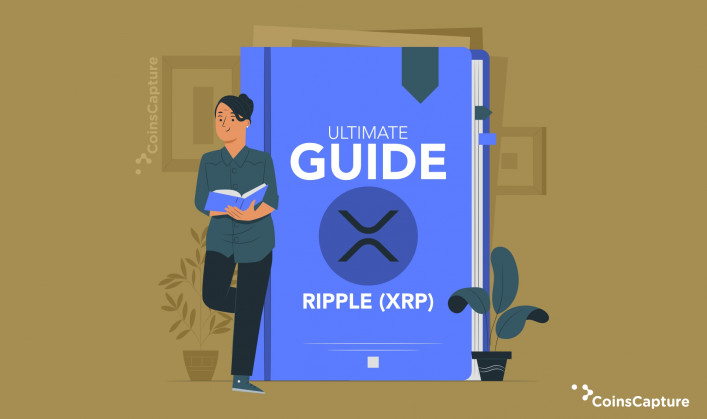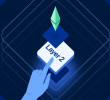12 February 2025
An Ultimate Guide to Ripple (XRP)
In the financial sector, Ripple is a network for transferring funds that meets the requirements of the sector. XRP is the Ripple network's native Crypto, and it is frequently one of the most popular ten Cryptos. The organization Ripple is responsible for XRP as well as the worldwide related payment platform as well as currency conversion networks it facilitates. Ripple's original intent was to serve as a substitute for SWIFT or another similar settlement tier amongst large financial institutions. Since the system can immediately verify that the exchange took place as intended, it acts as a trusted agent between the two parties involved in the transaction. Ripple may be used to convert between various fiat currencies and digital currencies like Bitcoin.
Also Read: Digital Payment Token & AML Regulations In Singapore
The Cryptocurrency, which debuted in 2012, has among the industry's loftiest objectives. The XRP Ledger, the software that enables the usage of XRP, presented a new method of running blockchains that its supporters argue is better suited for transactions. Anyone may help verify Bitcoin transactions and ensure the blockchain's security by contributing computer energy. Contrarily, the XRP Ledger restricts validation of transactions and network security to an exclusive group of network members. These individuals make up the Unique Node List and number over 150 in the network.
Also Read: LDO And CEL Outclass Bitcoin And Ethereum In 2022
How to Mine XRP?
Many blockchain-based Cryptocurrencies employ a distributed verification technique called "mining." It not only allows for transactions to take place, but also offers the means by which more bitcoin is added to the system, usually as payment for the efforts of verifiers in maintaining the network. In the case of Bitcoin, for instance, the total number of tokens that may ever exist is capped at 21 million, and new ones are only mined when transactions are confirmed. In addition, 100 billion XRP units were "pre-mined" on the XRP Ledger and afterward issued to the people at regular intervals. With a stake in the Cryptocurrency at stake, Ripple has an interest in seeing XRP thrive. A further fraction of XRPs is set aside for periodic distribution via transactions.
How Does Ripple Work?
Ripple's RippleNet blockchain technology was designed to facilitate fast, cheap, as well as easy international money transfers between banks. Therefore, it's an attractive replacement for SWIFT, the present international payments system utilized by the vast majority of institutions. There are several advantages of using Ripple for cross-border payments. The XRP virtual money uses a consensual structure combining numerous bank-owned servers to confirm transactions. By comparing proposed transactions to the most up-to-date edition of the XRP Ledger, verifiers ensure that only legitimate ones are processed. Any given transaction may only be considered legitimate if it receives approval from a sufficient number of verifiers.
How You Can Use Ripple and XRP?
Like other digital currencies, XRP may be traded or invested in the identical ways. The Ripple network might be used for other kinds of transactions as well, such as currency exchanges. In order to avoid the fees associated with using a financial institution or currency exchange to convert your funds, you may utilize the Ripple network to convert your cash into XRP and then use it to purchase euros. As opposed to using traditional banking services or a payment processing company, which may take a long time and cost a lot of money in fees, this option may be considerably quicker as well as more cost-effective.
History of Ripple (XRP)
In the vast majority of cases, it is possible to attribute the creation of a Cryptocurrency to a single person or organization. For instance, Bitcoin (BTC) was developed by a person under the name Satoshi Nakamoto. The development of XRP is fraught with human and organizational complexity, since many hands went into its inception and expansion. XRP is widely believed to have been created by Jed McCaleb, who also established Mt. Gox, whereas Arthur Britto, who contributed to the development of the XRP Ledger, and Chris Larsen, who started many fintech startups. Even though they remained major players in the area, there were others participating. David Schwartz, who together with Stefan Thomas co-authored the first Ripple whitepaper and continues to work as Ripple's CTO, is among these people.
Benefits of Ripple (XRP)
The listed below are some of the four most significant benefits or advantages that using Ripple (XRP) may provide:
- Fast Settlement
The time it takes to authenticate transactions is very little. This takes around four to five seconds for a Bitcoin transaction to be validated, but it may take a bank several days to process a wire transmission.
- Very Low Fees
On the Ripple network, the transaction fee is 0.00001 XRP, or around one-hundredth of one cent at the existing exchange rate.
- Versatile Exchange Network
Not only may XRP-based trades be processed on the Ripple network. However, it is not limited to the US dollar or bitcoin; various fiat money as well as Cryptos may be utilized as well.
- Used by Financial Institutions
Ripple may be used as a payment system by both small organizations and big organizations. Already more major financial institutions are using this network than are adopting most Cryptos, as shown by the fact that Santander as well as Bank of America (BoA) are among its users.
How to Buy Ripple (XRP) Cryptocurrency?
Use of XRP requires acquisition of the asset. Buyers of XRP have a number of options, including CEX, P2P investments, and decentralized exchanges (DEXs). It is common practice to send fiat currency like USD, EUR, JPY, and so on, to a centralized Cryptocurrency exchange through bank transfer when buying XRP there. Multiple Cryptocurrency markets now accept major credit cards as payment for digital assets. Additionally, based on the platform, you may be able to purchase XRP using a different Cryptocurrency as payment.
Disclaimer: The author’s thoughts and comments are solely for educational reasons and informative purposes only. They do not represent financial, investment, or other advice.






